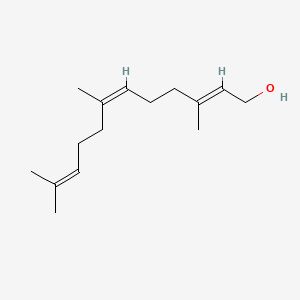| MeSH term | MeSH ID | Detail |
|---|---|---|
| Adenocarcinoma | D000230 | 166 associated lipids |
| Lung Neoplasms | D008175 | 171 associated lipids |
| Body Weight | D001835 | 333 associated lipids |
(e,z)-farnesol
(e,z)-farnesol is a lipid of Prenol Lipids (PR) class.
Cross Reference
There are no associated biomedical information in the current reference collection.
Current reference collection contains 3613 references associated with (e,z)-farnesol in LipidPedia. Due to lack of full text of references or no associated biomedical terms are recognized in our current text-mining method, we cannot extract any biomedical terms related to diseases, pathways, locations, functions, genes, lipids, and animal models from the associated reference collection.
Users can download the reference list at the bottom of this page and read the reference manually to find out biomedical information.
Here are additional resources we collected from PubChem and MeSH for (e,z)-farnesol
Possible diseases from mapped MeSH terms on references
We collected disease MeSH terms mapped to the references associated with (e,z)-farnesol
PubChem Biomolecular Interactions and Pathways
All references with (e,z)-farnesol
Download all related citations| Authors | Title | Published | Journal | PubMed Link |
|---|---|---|---|---|
| Grossman R et al. | Increase in peripheral benzodiazepine receptors and loss of glutamate NMDA receptors in a mouse model of closed head injury: a quantitative autoradiographic study. | 2003 | Neuroimage | pmid:14683703 |
| Scheper MA et al. | Farnesol, a fungal quorum-sensing molecule triggers apoptosis in human oral squamous carcinoma cells. | 2008 | Neoplasia | pmid:18714396 |
| Fukada Y et al. | Farnesylated gamma-subunit of photoreceptor G protein indispensable for GTP-binding. | 1990 | Nature | pmid:2385292 |
| Lowy DR and Willumsen BM | Protein modification: new clue to Ras lipid glue. | 1989 | Nature | pmid:2677741 |
| Goldstein JL and Brown MS | Regulation of the mevalonate pathway. | 1990 | Nature | pmid:1967820 |
| Farag MA and Al-Mahdy DA | Comparative study of the chemical composition and biological activities of Magnolia grandiflora and Magnolia virginiana flower essential oils. | 2013 | Nat. Prod. Res. | pmid:22690913 |
| Lichtor PA and Miller SJ | Combinatorial evolution of site- and enantioselective catalysts for polyene epoxidation. | 2012 | Nat Chem | pmid:23174978 |
| Cotoras M et al. | Farnesol induces apoptosis-like phenotype in the phytopathogenic fungus Botrytis cinerea. | 2013 Jan-Feb | Mycologia | pmid:22962358 |
| Gonçalves O et al. | Evaluation of the mutagenicity of sesquiterpenic compounds and their influence on the susceptibility towards antibiotics of two clinically relevant bacterial strains. | 2011 | Mutat. Res. | pmid:21453784 |
| Jin J et al. | Farnesol, a potential efflux pump inhibitor in Mycobacterium smegmatis. | 2010 | Molecules | pmid:21042264 |
| Å piÄáková A et al. | Nerolidol and Farnesol Inhibit Some Cytochrome P450 Activities but Did Not Affect Other Xenobiotic-Metabolizing Enzymes in Rat and Human Hepatic Subcellular Fractions. | 2017 | Molecules | pmid:28338641 |
| Togashi N et al. | Effects of two terpene alcohols on the antibacterial activity and the mode of action of farnesol against Staphylococcus aureus. | 2008 | Molecules | pmid:19078849 |
| Rung E et al. | Depletion of substrates for protein prenylation increases apoptosis in human periovulatory granulosa cells. | 2006 | Mol. Reprod. Dev. | pmid:16868926 |
| Benford HL et al. | Farnesol and geranylgeraniol prevent activation of caspases by aminobisphosphonates: biochemical evidence for two distinct pharmacological classes of bisphosphonate drugs. | 1999 | Mol. Pharmacol. | pmid:10385693 |
| Maher M et al. | Activation of TRPA1 by farnesyl thiosalicylic acid. | 2008 | Mol. Pharmacol. | pmid:18171730 |
| Bandara HM et al. | Incorporation of Farnesol Significantly Increases the Efficacy of Liposomal Ciprofloxacin against Pseudomonas aeruginosa Biofilms in Vitro. | 2016 | Mol. Pharm. | pmid:27383205 |
| Zhang X et al. | PEG-farnesyl thiosalicylic acid telodendrimer micelles as an improved formulation for targeted delivery of paclitaxel. | 2014 | Mol. Pharm. | pmid:24987803 |
| Savoldi M et al. | Farnesol induces the transcriptional accumulation of the Aspergillus nidulans Apoptosis-Inducing Factor (AIF)-like mitochondrial oxidoreductase. | 2008 | Mol. Microbiol. | pmid:18681941 |
| Bai C et al. | Characterization of a hyperactive Cyr1 mutant reveals new regulatory mechanisms for cellular cAMP levels in Candida albicans. | 2011 | Mol. Microbiol. | pmid:21992526 |
| Hogan DA et al. | A Pseudomonas aeruginosa quorum-sensing molecule influences Candida albicans morphology. | 2004 | Mol. Microbiol. | pmid:15554963 |
